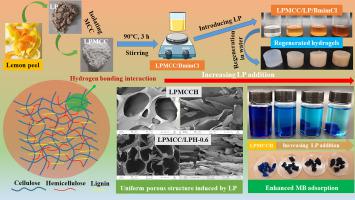International Journal of Biological Macromolecules ( IF 7.7 ) Pub Date : 2021-09-17 , DOI: 10.1016/j.ijbiomac.2021.09.063 Hongjie Dai 1 , Yuan Chen 2 , Liang Ma 1 , Yuhao Zhang 1 , Bo Cui 3

|
In this study, we developed a facile and eco-friendly fabrication of hydrogels based on lemon peel (LP) and its isolated microcrystalline cellulose (LPMCC) by direct co-dissolving in 1-butyl-3-methylimidazolium chloride (BmimCl), followed by direct regeneration in distilled water to form hydrogels. The influence of LP addition on the structure and methylene blue (MB) adsorption of the hydrogels was systematically investigated. The hydrogels displayed a physically cross-linked network through hydrogen bonding interactions. Compared with pure LPMCC hydrogel, the introduction of LP increased the porosity and improved the thermal stability of the hydrogels. The adsorption process of MB on the hydrogels conformed better to the pseudo-second-order kinetic (R2 > 0.993) and Langmuir isotherm models (R2 > 0.996). The MB adsorption process was feasible, spontaneous and exothermic in nature, and was influenced by initial MB concentration, pH, temperature, ionic type and strength. Notably, the introduction of LP improved MB adsorption capacity of the hydrogels. This work develops a facile approach of agricultural by-products based hydrogels using pure cellulose as the structural skeleton and untreated lignocellulose components as the structure modifier.
中文翻译:

基于柠檬皮及其分离的微晶纤维素的水凝胶的直接再生:亚甲基蓝吸附的表征和应用
在这项研究中,我们通过直接共溶解在 1-丁基-3-甲基咪唑氯化物 (BmimCl) 中,开发了一种基于柠檬皮 (LP) 及其分离的微晶纤维素 (LPMCC) 的简便环保的水凝胶制造,然后在蒸馏水中直接再生形成水凝胶。系统地研究了 LP 添加对水凝胶结构和亚甲蓝 (MB) 吸附的影响。水凝胶通过氢键相互作用显示出物理交联的网络。与纯LPMCC水凝胶相比,LP的引入增加了水凝胶的孔隙率并提高了水凝胶的热稳定性。MB在水凝胶上的吸附过程更符合准二级动力学(R 2 > 0.993)和Langmuir等温线模型(R 2 > 0.996)。MB 吸附过程是可行的、自发的和放热的,并受初始 MB 浓度、pH、温度、离子类型和强度的影响。值得注意的是,LP 的引入提高了水凝胶的 MB 吸附能力。这项工作开发了一种使用纯纤维素作为结构骨架和未经处理的木质纤维素组分作为结构改性剂的基于农业副产品的水凝胶的简便方法。









































 京公网安备 11010802027423号
京公网安备 11010802027423号